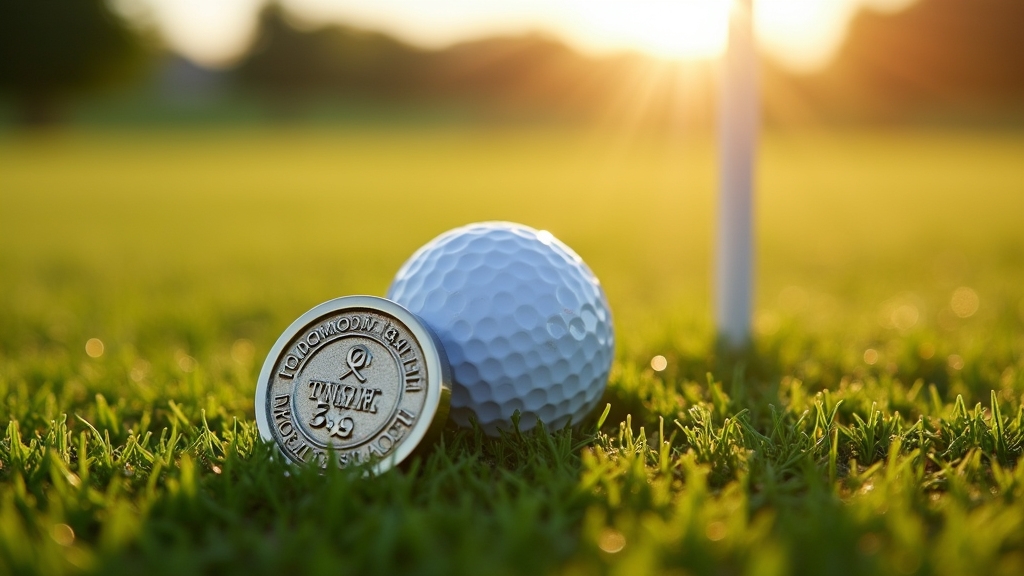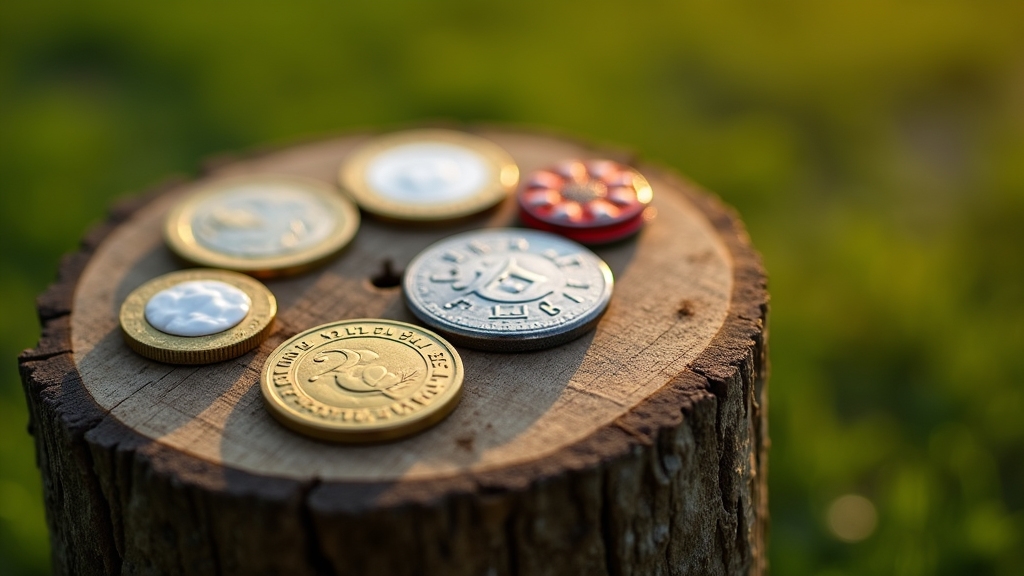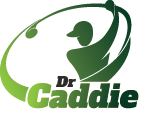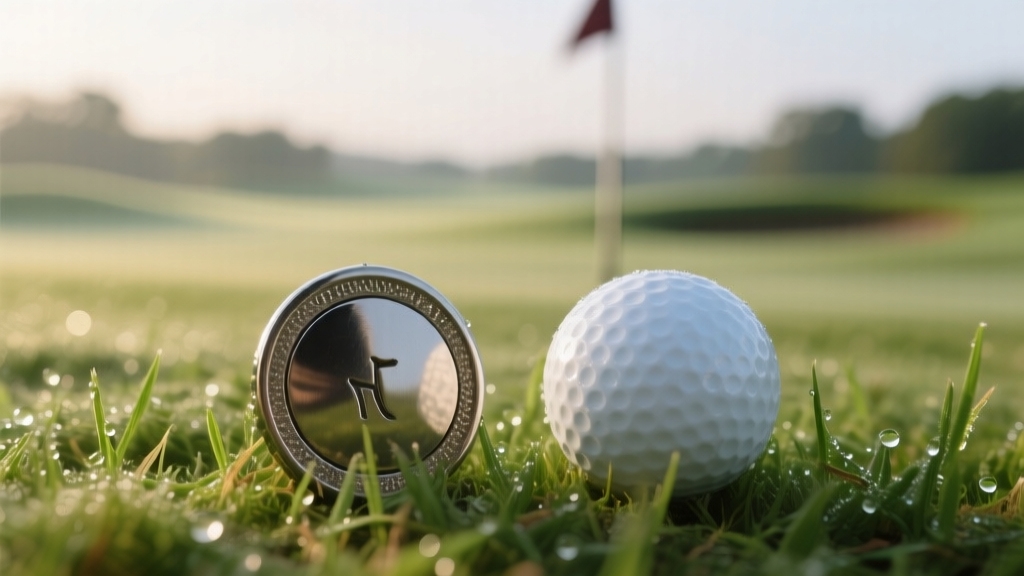Golf ball markers are small, flat objects you use to mark your ball’s exact position on the green before lifting it. They help you replace the ball accurately, maintain game integrity, and follow official rules, which require artificial markers no larger than 1.5 inches.
Markers come in various materials like metal or plastic and often feature personalized designs for easy identification and stability. Understanding their correct use guarantees precise play and improved performance. Explore further to uncover their types, regulations, and practical tips.
- Key Takeaways
- Definition and Purpose of Golf Ball Markers
- Rules and Regulations Concerning Ball Markers
- Types and Materials of Golf Ball Markers
- Importance and Benefits of Using Golf Ball Markers
- Procedure for Marking and Replacing the Ball
- Variations and Additional Uses of Ball Markers
- Tips for Choosing the Right Golf Ball Marker
- Frequently Asked Questions
- Can Golf Ball Markers Be Personalized With Logos or Names?
- How Do Magnetic Ball Markers Attach to Golf Hats or Belts?
- Are There Eco-Friendly Materials Used for Golf Ball Markers?
- Can Ball Markers Affect the Speed or Roll of a Golf Ball?
- How Do Professional Golfers Choose Their Ball Markers for Tournaments?
- Proper Use of Golf Ball Markers to Enhance Accuracy and Fair Play
Key Takeaways
- Golf ball markers are small, flat objects used to mark a golf ball’s position on the green during play.
- They ensure accurate ball replacement, maintaining game integrity and adherence to rules.
- Markers are made from metal, plastic, wood, or specialty materials and must be artificial and under 1.5 inches.
- They often feature visual guides, personalization, and multifunctional designs like magnetic attachments or divot tools.
- Proper use involves placing the marker adjacent to the ball before lifting and replacing the ball precisely on the marked spot.
Definition and Purpose of Golf Ball Markers

Although you mightn’t always notice them, golf ball markers play an essential role on the putting green by marking the exact spot where your ball rests when you need to lift it. A golf ball marker is a small, flat object, often a coin, tee, or specialized disc, that precisely indicates your ball’s position.
By using a marker, you prevent confusion about where your ball was, ensuring accurate replacement. This is critical when you must lift the ball to avoid interference with other players’ lines or to clean it. Markers are considered artificial objects such as coins or tees, as defined by the R&A.
Markers uphold the integrity of play by maintaining order, preventing disputes, and supporting adherence to golf’s rules and etiquette. They also enable smooth gameplay by clearly defining each ball’s original spot. Understanding equipment rules, including the use of markers, helps players maintain consistent performance and fairness on the course.
Rules and Regulations Concerning Ball Markers
When you mark your golf ball’s position, you must follow specific rules to guarantee fair play and compliance with the official regulations. You can place the ball marker immediately next to the ball—behind, in front, or on either side—but never use natural objects like leaves.
The marker must be artificial, no larger than 1.5 inches in diameter, and can’t have added features such as measuring tools. Placing or replacing the ball incorrectly results in a one-stroke penalty.
Remember these critical points:
- Mark the exact spot for precise ball replacement.
- Use only approved artificial markers within size limits.
- Avoid alignment devices disguised as ball markers.
- Always replace the ball on the original spot to prevent penalties.
For those transporting equipment, ensure that items like ball markers are securely stored during travel, similar to securing a golf cart with adjustable tie-downs and ratchet straps.
Types and Materials of Golf Ball Markers

Since golf ball markers serve both functional and aesthetic purposes, understanding the types and materials available helps you select the right one for your needs.
Metal markers, such as stainless steel, titanium, and zinc alloy, offer superior durability, corrosion resistance, and a premium feel. Metal markers provide a timeless look that enhances the golfing experience and withstands the rigors of the game. Their weight and texture can also influence how easily they are handled and placed on the green, similar to how grip diameter affects control in golf grips.
Zinc alloy balances affordability and customization well. Plastic markers are lightweight, cost-effective, and non-damaging to greens but less durable. Their lightness makes them easy to carry, though they may require more frequent replacement compared to heavier options.
Wood markers provide natural charm and eco-friendliness, often handcrafted with unique grain patterns but are less resistant to wear. Specialty materials like Damascus steel, tungsten, and precious metals like gold and silver cater to collectors and those seeking luxury or commemorative markers.
Custom options frequently combine materials and intricate designs, allowing you to personalize your marker while maintaining functionality on the course.
Importance and Benefits of Using Golf Ball Markers
Using golf ball markers is vital for adhering to the rules and maintaining fairness during play. Marking your ball prevents penalties by ensuring you lift it properly and helps identify your ball, avoiding costly mistakes. It preserves the pace of play by allowing quick ball lifting and replacement without disrupting others, which is essential for maintaining proper posture and focus during the game.
Markers enhance your accuracy by maintaining exact ball position, which is essential for precise putting. Additionally, using markers reflects respect for fellow players and the game’s etiquette, fostering a courteous environment. Many markers also feature custom designs that allow players to express their individual style and personality on the green.
- Avoid penalties and maintain your score integrity
- Keep the game flowing smoothly without delays
- Improve putting precision with exact ball alignment
- Show sportsmanship and respect on the green
Golf ball markers are more than tools; they’re key to fair, efficient, and respectful play.
Procedure for Marking and Replacing the Ball
Marking your golf ball correctly guarantees you maintain the exact position needed for a fair and accurate game. Place an artificial marker, such as a coin or tee, immediately adjacent to the ball’s original spot before lifting it. The marker must be anartificial object], as natural items like leaves or twigs are not permitted.
Ascertain this marker doesn’t exceed 1.5 inches in diameter and avoid natural objects. Marking must occur prior to lifting; otherwise, penalties apply. Using proper grip pressure while placing the marker can help maintain stability during the process.
When replacing, set the ball by hand precisely on the marked location. You may use the original or an identical substitute ball. Avoid rolling the ball into place.
Use your original ball or an exact match, placing it carefully without rolling it into position.
If the ball accidentally hits the marker during a stroke, replace it without penalty and adjust the marker as needed. Failure to mark, improper replacement, or use of illegal markers results in a one-stroke penalty or disqualification in official play.
Variations and Additional Uses of Ball Markers
You’ll find ball markers with alignment features designed to assist in precise putting by providing visual guides. Some markers incorporate multi-purpose designs, combining functions such as magnetic attachments or training aids. These variations enhance both gameplay accuracy and convenience on the course.
Additionally, magnetic markers offer quick attachment and easy access, making them a popular choice for many players. Using markers with alignment aids can help maintain a smooth rhythm and steady tempo during putting, which is crucial for consistent performance.
Alignment Features
Although ball markers serve the basic purpose of marking your ball’s position, modern alignment features considerably expand their functionality. You can use rotating alignment markers that stabilize with dual spikes, letting you fine-tune your ball’s aim without shifting its position.
This design is fully compliant with golf rules, making it suitable for tournament play. Proper hip and shoulder alignment when marking your ball can also help reinforce consistent setup habits.
Line and pattern markers on balls provide visual guides parallel to the target line, helping you maintain consistent stroke alignment. Some markers include reference points around the perimeter to assist with body and clubface positioning, enhancing shot consistency.
- Rotate alignment guides 360° for precise target line adjustment
- Use line markers to reinforce muscle memory and stroke quality
- Place markers strategically on the green for improved directional accuracy
- Review ball roll relative to markers to refine future putts
Multi-Purpose Designs
When selecting ball markers, considering multi-purpose designs can enhance both functionality and personal expression on the green. You can choose markers embossed with initials or motivational quotes, boosting personal identity and focus. Bold colors or team logos improve visibility and style during play.
Magnetic markers conveniently attach to hats or divot tools, reducing loss and ensuring quick access while allowing players to comply with venue dress codes. Incorporating durable materials such as brass or stainless steel ensures longevity and a premium feel.
Corporate branding options serve promotional purposes at tournaments, fostering client relationships and brand recall. Materials vary from durable metals to lightweight plastics, allowing you to balance longevity and color customization.
Some markers even double as keychains or collectibles, adding multifunctionality. Novelty designs featuring lucky symbols or iconic courses provide aesthetic appeal and conversation starters, making your ball marker a practical yet personalized tool.
Tips for Choosing the Right Golf Ball Marker
Since the material and design directly influence performance and durability, choosing the right golf ball marker requires careful consideration of factors like weight, stability, and customization.
You should select a marker material that suits your playing conditions. Metal offers durability and stability, plastic provides lightweight portability, while resin and wood add unique textures or aesthetics. Metal markers tend to be more expensive but are often chosen for their ruggedness and premium appearance.
Consider size and weight; heavier markers resist wind displacement, and larger sizes improve visibility. Proper weight distribution, similar to club construction principles, enhances stability during play. Customization enhances identification and personal style, and some markers include alignment aids or divot repair tools for added functionality.
- Feel confident with a durable, corrosion-resistant metal marker
- Enjoy personalized style through detailed engraving
- Experience stable placement even on windy courses
- Benefit from multifunctional designs that speed up play
Frequently Asked Questions
Can Golf Ball Markers Be Personalized With Logos or Names?
Yes, you can personalize golf ball markers with logos or names. You’ll find options like laser engraving on metal markers and full-color printing on plastic ones, allowing detailed customization. Whether you want your initials, a company logo, or a short quote, these methods guarantee clarity and durability.
Plus, you can choose different sizes, colors, and even multifunctional designs with magnetic clips, making your personalized marker both stylish and practical on the course.
How Do Magnetic Ball Markers Attach to Golf Hats or Belts?
You might think magnetic ball markers just stick randomly, but they actually attach quite cleverly. They snap onto metal clips embedded in your hat or belt using powerful neodymium magnets.
These clips often have protective lips to keep markers secure during movement. This magnetic bond guarantees quick access without the risk of losing your marker, blending convenience with precision engineering right on your golf apparel.
Are There Eco-Friendly Materials Used for Golf Ball Markers?
Yes, you’ll find eco-friendly golf ball markers made from sustainable materials like bamboo and recycled wood, which are biodegradable and reduce plastic waste. Recycled composites and metal alloys with recycled content also minimize environmental impact while maintaining durability.
Many markers now combine multifunctionality and magnetic features to extend lifespan. Choosing these options supports sustainability efforts by lowering resource extraction, waste, and chemical use in golf accessories production.
Can Ball Markers Affect the Speed or Roll of a Golf Ball?
You might wonder if ball markers affect your golf ball’s speed or roll, but they don’t—provided you place and replace the ball correctly. Markers only serve to mark position; they don’t alter friction or velocity directly. However, if you inaccurately replace the ball or use uneven markers, minor deviations in roll or speed can occur due to altered contact points.
How Do Professional Golfers Choose Their Ball Markers for Tournaments?
You choose ball markers for tournaments based on strict size and material regulations, ensuring they don’t exceed 1.5 inches in diameter and remain flat to avoid interfering with play. You prefer durable, metal markers—often coins or custom designs—that are lightweight, visible, and withstand repeated use.
Customization helps with quick identification without violating rules. Your choice balances functionality, compliance, and personal branding, preventing delays or penalties during competitive rounds.
Proper Use of Golf Ball Markers to Enhance Accuracy and Fair Play
Now that you know golf ball markers are essential for accurate play and adhering to the rules, you might wonder if any marker will do. The truth is, using the right marker—one that’s visible, durable, and fits your style—can actually speed up your game and prevent penalties. So, don’t just pick any marker; choose one that enhances your precision and efficiency on the course.

